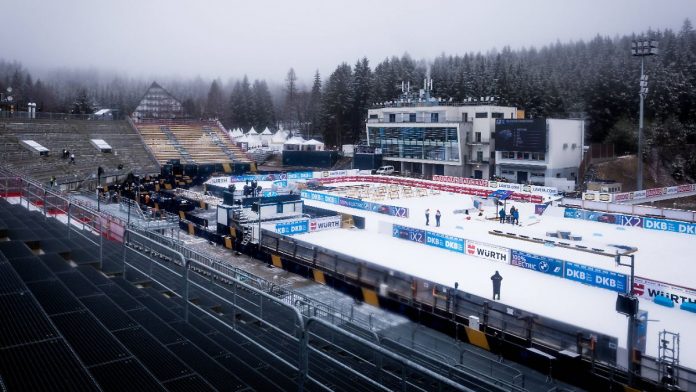World champion very worried
Biathlon has to answer unpleasant questions
Climate change does not stop at biathlon. The World Cup in Nove Mesto is only possible with a lot of artificial snow and temperatures are well above zero degrees. This will probably mean major upheavals in the World Cup calendar in the future.
A thin layer of white snow provided a bit of a wintry atmosphere, at least for a short time, but hosting the Biathlon World Championships in Nove Mesto is a feat of strength. Temperatures in some cases well above freezing, constant rain and storms made preparations more difficult and raised the question once again on the first day of the competition: How long will professional winter sports be possible in Central Europe far from Alpine regions if there is no longer any reliable cold and snow even at the beginning of February gives?
“I am of course worried about the future of our sport,” said Julia Simon. The Frenchwoman had just received her gold medal for winning the mixed relay. To do this, she trudged through the cross-country ski trail in the Czech forests on Wednesday in deep artificial snow and relentless rain. “It's not easy to see that and it's happening more and more often and faster,” said the 27-year-old about the changes caused by advancing climate change. World Cups have been in jeopardy several times recently, and courses in Germany and France have also been prepared with great effort. Already in 2016 there was a complete cancellation in Oberhof due to weather.
“We have to think about the future, how we can still do biathlon,” said overall World Cup winner Simon: “We are lucky that the IBU is looking for solutions.” At this same world association, the topics of sustainability and climate change play a major role, and the organizers' ecological footprint is also taken into account. The next few years will be challenging because the climate crisis is likely to mean that there will be less snow and increasingly shorter periods of cold in many places. In France, snow was delivered by truck at the end of 2022 to save the event. Such scenarios should be prevented at all costs in the future.
The goal: “The best possible conditions at each location”
So what to do? A biathlon calendar for the future is being discussed at the world association. The program has been finalized until the 2025/2026 season; the first adjustments will probably only be made in the period up to 2030. Even then, a revolution is still not to be expected, we hear. Because taking the interests of all organizers into account is difficult. Among other things, it's about hotel capacities, but also about a lot of vanities. It remains to be seen whether the length of the season will be changed, new regions will have to be opened up or whether hosts will lose their World Cup status.
There are also considerations in Germany. The German Ski Association (DSV) is starting a debate about the future calendar and would like a date for the races in Oberhof later in January and not directly after New Year's Eve. “It is important that we ultimately find a solution that ensures that the best possible conditions are available at each location,” said Stefan Schwarzbach, Director of Communications at DSV. There is no question that Germany wants to keep both World Cups in Thuringia and Ruhpolding in Bavaria from the winter of 2026/2027.
“The areas where snow is guaranteed are becoming fewer,” climate researcher Werner Aeschbach from the Institute for Environmental Physics in Heidelberg told the German Press Agency last year: “But there will still be a lot of snow at 2,000 meters. Below 1,000 meters “But this security will no longer exist in the medium term.”
A future without snow is possible
This can also be seen in Nove Mesto, which is almost 600 meters above sea level. It is only thanks to a large snow depot, which is standard in many places, that the World Cup can be held despite significantly plus temperatures. 20,000 cubic meters of artificial snow have been applied to the trails, and a further 50,000 cubic meters are available for the eleven remaining races until February 18th. It's not expected to get much colder than five degrees this weekend, and more rain is forecast. “The greatest possible praise goes to the organizers for organizing competitions at World Cup level under these conditions,” said IBU media director Christian Winkler.
At the upcoming World Cup in 2025 in Lenzerheide/Switzerland and at the Winter Olympics a year later in Antholz/Italy, there will be well over 1200 meters into the high mountains, which promises guaranteed snow. After the first World Championships in Estonia in 2027, it is not yet clear who will host the next title fights.
Due to the lack of snow, training on roller skis has long been a reality. In warm months there are already world championships in summer biathlon on the compact ski replacement. It still seems a long way off that this will eventually replace waxed boards in winter. At least the ski hunters would have a future without snow – which will certainly take some getting used to – and which does not exist, for example, in alpine ski racing or other disciplines.


